Fiber Optics Solutions
subota, 28.02.2015.
Fake SFP and the Third Party SFP
It appears to be an old topic that whether using compatible SFP transceiver is reliable. We have previously discussed this topic couple of days ago. For certain, the reply is affirmative. In this paper we discuss Faked SFP and the Third Party SFP. As examples, there are Cisco SFP module and Brocade SFP module.

It Is A Faked SFP?
Like a break pad an SFP is somewhat a consumable. Light is converted into an electric signal and vice versa, produces heat and the components wear out over time. Some sooner, some later. When you bought the SFPs from Cisco for a switch under Cisco warranty or maintenance, broken SFPs will be substituted for free. However, if you simply decide to purchase an SFP, you will find after having a quick web search that there are lots of supplier out there providing the same SFP for a much cheaper price than Cisco. And with "the same SFP" I mean they provide exactly the same Cisco part number - for example Cisco GLC-SX-MM. That's an 1000BASE-SX SFP 850nm 550m transceiver.
Really The Same SFP?
Absolutely not - even though they claim it to be the same. Their usual explanation is, that all these SFPs are coming from the same manufacturer anyway. SFPs are built using open standards based on T11 and for that reason they must be compatible per se. I can tell from several occasions: That's not true. There is obviously more than one SFP manufacturer and I'm sure each of you know a handful offhand. In addition: Even in times before 8G there were SFPs working much better with certain switches than others.
Utilizing the 8G platform Brocade decided to offer Brocade branded SFPs and restricted their switches to only support them and to refuse others (beside of very few exceptions for CWDM SFPs). So Brocade took control over which SFPs can be used and they were able to fine tune their ASICs to allow better signal handling and transmission. To enforce that the switch checks the vendor information from the SFP to determine if it's a Brocade branded one. Cisco does the same thing for the SFPs in their switches.
Faked SFP vs Third Party SFP
First, we must realize that Third Party SFP isn't faked SFP. If you are seeking further savings on your own network, consider Third Party SFP. When you purchase from a vendor with their own in-house shop, and guaranteed warranty, you get a purchase that's as reliable as new, at a fraction of the original costs. In my opinion, if you have enough budget, It is best to buy the original one. It doesn’t mean that the compatible one is as not good as the original one but you could save more time in thinking about this question. If you care about the cost, compatible one is the best choice, I suggest you choose the OEM manufacturers.
OEM manufacturers Recommendation
Fiberstore is a OEM manufacturer that provide customized solutions for fiber optics needs, As a Cisco OEM SFP transceiver provider, they offer a series of Cisco comaptible SFP modules which can be equivalent to Cisco GLC-T, Cisco GLC-SX-MM, Cisco GLC-LH-SM, Cisco GLC-ZX-SM, and Cisco CWDM SFP, Cisco DWDM SFP, etc. All their SFP transceivers are 100% compatible with major brands as follows and backed by a lifetime warranty.
Oznake: Third Party SFP, Faked SFP, Cisco SFP, GLC-T
četvrtak, 26.02.2015.
Fiber Optic Transceivers Today and Tomorrow
Fiber optic transceivers is a self-contained component that can both transmit and receive. Usually, it is inserted in devices such as routers or network interface cards which provide one or more transceiver module slot, such as GBIC module, SFP transceiver, XFP, etc.
Fiber Optic Transceivers Today
Fiber optic transceivers for applications in the field of datacom are mostly characterized by a couple of established international standards. These standards define the electro-optical performance of a transceiver/transponder as well as its pinout and its physical outline and package, including the corresponding fiber optic connector interfaces.
Fiber optic transceivers meeting these standard are operating worldwide in numerous applications in mainframes, server clusters, storage area networks, wide area networks, and local area networks, and currently around 20 to 30 worldwide competing suppliers have been established. The number of partners involved in some important multisourcing agreements has seen an increase since 1989. This is also indicative of the increasing importance of industrial associations where both suppliers and applicators are represented. This speeds up the market penetration of novel components, systems, and applications. Nowadays, this does not seem to generate conflicts with the commonly agreed normative power of international standardization organizations such as the Internationnal Organization for Standardization (ISO), International Electrotechnical Commission (IEC), and International Telecommunication Union (ITU).

The demand for these transceivers has continuously increased during the past 10 years, and the prices have shown dramatic decreases of order of 25% per year. Consequently, the goal of all manufacturers is to offer a high level of performance, reliability, quality, and serviceability while maintaining cost-effective production in the face of drastically increased volumes to meet the market pricing.
Some Aspects of Tomorrow's Transceivers
The bit rates of fiber optic transceivers are continuously increasing in order to meet the worldwide demand for ever higher bandwidths. These bandwidth increases are called for by both existing storage and networking markets, as well as the parallel computing industry and high end server design.
In the past 10 years, a significant reduction of transceiver module size was possible due to significant progress in the downsizing of optical subassemblies and associated passive and active electronic comparison of the ESCON/SBCON outline, multistandard, small form factor (SFF), and parallel SNAP-12 transceivers. The function of the transceivers shown is described in detail in my previous blog posts.
Future transceiver design is likely to focus on power consumption, electromagnetic compatibility and immunity, and density. As data rates continue to increase, we will start to see transceivers used closer to the ICs on the board and not just at the card edge. It has also been demonstrated the is possible to incorporate optical components onto a chip, completely avoiding the deficiencies of high-speed signals on copper board traces. While these advancements may take their place in high-end computing systems, classical card edge transceivers are likely to continue to play their role into the foreseeable future to allow fiber cable connection for SANs and networking.
Where to Buy Fiber Optic Transceivers
Fiber optic transceiver is a very popular format that's recommended by a large number of fiber optic component providers. Fiberstore provide a full range of optical transceivers. Cisco, especially, you can find a full product line of our New Cisco SFP modules, such as GLC-T SFP, SFP-GE-T, GLC-SX-MM, etc. Our SFP and SFP+ moduels are 100% compatible with a good price and enjoy same-day shipping.
Oznake: Fiber Optic Transceivers, SFP, Cisco SFP
petak, 13.02.2015.
What is the difference between GLC-T and SFP-GE-T?
What is the difference between SFP-GE-T and GLC-T? I have some information from Cisco Support Forums:
- GLC-T, 1000BASE-T SFP transceiver module for Category 5 copper wire, RJ-45 connector.
- SFP-GE-T, 1000BASE-T SFP transceiver module for Category 5 copper wire, extended operating temperature range, RJ-45 connector

GLC-T 1000BASE-T SFP, which is a fiber optic transceiver module via Category 5 copper lines, Cisco GLC-T fiber transceivers provide 1Gbps data transfer and it provides full-duplex Gigabit Ethernet connectivity to high-end workstations and between wiring closets over existing copper network infrastructure. GLC-T SFP is compliant to IEEE 802.3 and its dimension is 0.6 in x 2.8 in x 0.6 in. GLC-T is with plug in module type Mini-GBIC.
3rd-party GLC-T Key Features
- Support 1000BASE-T Operation in Host Systems
- For 100m reach over Cat 5 UTP Cable
- Hot-Pluggable SFP Footprint
- Support RX_LOS as Link indication function
- Fully metallic enclosure for low EMI
- Low power dissipation (1.05 W typical)
- Compact RJ-45 connector assembly
- Compliant with SFP MSA and IEEE Std 802.3-2002
- Detailed product information in EEPROM
- Commercial temperature range (COM): 0 to 70°C
Cisco SFP-GE-T works with 1000BASE-T. SFP-GE-T is with extended working temperature and it is with DOM support. SFP-GE-T is small form transceiver with RJ45 connector interface and it is with spring latch for high density applications.
3rd-party SFP-GE-T Key Features
- Support 1000BASE-T Operation in Host Systems
- For 100m reach over Cat 5 UTP Cable
- Hot-Pluggable SFP Footprint
- Support RX_LOS as Link indication function
- Fully metallic enclosure for low EMI
- Low power dissipation (1.05 W typical)
- Compact RJ-45 connector assembly
- Compliant with SFP MSA and IEEE Std 802.3-2002
- Detailed product information in EEPROM
- Commercial temperature range (COM):0 to 70°C
The third-party GLC-T and SFP-GE-T have the same Key Features. So no difference between them? I think that they are operationally identical and can be interchanged with no problems - the only difference is that the SFP-GE-T conforms to NEBS Level 3 and the GLC-T doesn't. And Then question is what is NEBS Level 3? I'll also add that the SFP-GE-T is a little bit more expensive...maybe $40 more (retail) but it works in switches or routers like the ASR while the GLC-T is for switches only.
What is NEBS and why is it important?
Long a requirement for equipment used in the Central Office in the North American Public Switched Network, the rigorous Network Equipment Building System (NEBS) criteria have become a universal measure of network product excellence. The NEBS compliance of GDC's products is a key advantage for access providers including Local Exchange Carriers (LECs), Competitive Access Providers (CAPs), Competitive Local Exchange Carriers (CLECs), Internet Service Providers (ISPs), and Access Service Providers (ASPs). Products that are NEBS certified are also expected to be top performers in enterprise net- work environments as well.
What does NEBS Level 3 Certified mean?
NEBS has three levels, Level 1, Level 2, and Level 3. Level 1 refers to cases where minimum compatibility with the environment is needed. Level 2 applies for limited operability of the product.
Finally, NEBS Level 3 certification guarantees the maximum operability of the equipment. It also certifies that the equipment will perform well in harsh environmental conditions and will not interfere with other electronic devices around. NEBS Level 3 certified networking equipment is vital in mission-critical applications. More information about NEBS please Google it.
In a word, GLC-T with 1000BASE-T standard, SFP-GE-T with 1000BASE-T NEBS 3 ESD. But, for a 3rd-party SFP module, I still don't know what the difference between them.
srijeda, 11.02.2015.
How to Install or Remove QSFP Transceiver Module
QSFP/QSFP+ Installing Steps
Step 1: Attach an ESD wrist strap to yourself and a properly grounded point on the chassis or the rack.
Step 2: Remove the QSFP+ transceiver module from its protective packaging.
Step 3: Check the label on the QSFP+ transceiver module body to verify that you have the correct model for your network.
Step 4: For optical QSFP+ transceivers, remove the optical bore dust plug and set it aside.
Step 5: For transceivers equipped with a bail-clasp latch:
a. Keep the bail-clasp aligned in a vertical position.
b. Align the QSFP+ transceiver in front of the module's transceiver socket opening and carefully slide the QSFP+ transceiver into the socket until the transceiver makes contact with the socket electrical connector.
Step 6: For QSFP+ transceivers equipped with a pull-tab:
a. Hold the transceiver so that the identifier label is on the top.
b. Align the QSFP+ transceiver in front of the module's transceiver socket opening and carefully slide the QSFP+ transceiver into the socket until the transceiver makes contact with the socket electrical connector.
Step 7: Press firmly on the front of the QSFP+ transceiver with your thumb to fully seat the transceiver in the module's transceiver socket.
Please Note: If the latch is not fully engaged, you might accidentally disconnect the QSFP+ transceiver module.
Step 8: For optical QSFP+ modules, reinstall the dust plug into the QSFP+ transceivers optical bore until you are ready to attach the network interface cable. Please Note: Do not remove the dust plug until you are ready to attach the network interface cable.
QSFP/QSFP+ Removing Steps
Step 1: For optical QSFP+ transceivers, disconnect the network interface cable from the QSFP+ transceiver connector.
Step 2: For QSFP+ transceivers equipped with a bail-clasp latch.
a. Pivot the bail-clasp down to the horizontal position.
b. Immediately install the dust plug into the transceivers optical bore.
c. Grasp the sides of the QSFP+ transceiver and slide it out of the module socket.
Step 3: For QSFP+ transceivers equipped with a pull tab latch
a. Immediately install the dust plug into the transceiver's optical bore.
b. Grasp the tab and gently pull to release the transceiver from the socket.
c. Slide the transceiver out of the socket.
Step 4: Place the QSFP+ transceiver into an antistatic bag.
Note: In fact, the installing or removing steps of the mentioned transceiver modules are the general case. Different transceiver modules of different brands have their own features. We should ask the vendor to get more informations when you face a problem that we do not mentioned here. In addition, to save more money, we suggest that compatible 3rd transceiver modules may be another good choice but you should ensure that your vendor is reliable.
Fiberstore's fiber optic transceivers are 100% compatible with major brands like Cisco, HP, Juniper, Nortel, Force10, D-link, 3Com. They are backed by a lifetime warranty so that you can buy with confidence. Additionally, customize optical transceivers to fit your specific requirements are available.
Cisco, especially, you can find a full product line of our New Cisco SFP modules, such as GLC-LX-SM-RGD, SFP-GE-T, GLC-SX-MMD, etc. Our SFP+ and QSFP+ moduels are 100% compatible with a good price and enjoy same-day shipping.
Ordering Information
- QSFP-4SFP10G-CU3M, Cisco QSFP+ to 4 SFP+ Passive Copper Direct Attach Breakout Cable features a single QSFP+ connector (SFF-8436) rated for 40-Gb/s on one end and 4 SFP+ connectors (SFF-8431), each rated for 10-Gb/s, on the other.
- SFP-H10GB-CU3M, SFP+ passive copper cable, Data Rate up to 10.5G, 3 meter, AWG30.
- GLC-SX-MM, GLC-SX 1000BASE-SX SFP transceiver, supporting dual data-rate of 1.25Gbps/1.0625Gbps and 550m transmission distance with MMF.
- GLC-T module, Cisco SFP To RJ45 converter for Category 5 copper wire compliant with the Gigabit Ethernet and 1000BASE-T standards.
- SFP-10G-SR 10GBASE-SR SFP module, offers the same function with Cisco SFP-10G-SR and it is fully compatible with Cisco devices.
Article Source: Guide of Installing or Removing Transceiver Modules (Part III)
Oznake: Cisco SFP, QSFP+, SFP, Transceiver module
ponedjeljak, 09.02.2015.
Cisco 10GBASE SFP+ Modules Overview
Overview and specifications of Cisco 10GBASE SFP+ modules, SFP-10G-LR, and SFP-10G-SR, etc.
Solution
Cisco transceiver modules: Cisco 10GBASE SFP+ modules.
Product overview: The Cisco 10GBASE SFP+ modules offer users a wide variety of 10 Gigabit Ethernet connectivity options for data center, enterprise wiring closet, and service provider transport applications.
Compatible Cisco SFP+ Copper (Twinax) cable and SFP+ Transceiver

Features and benefits:
Main features of Cisco 10GBASE SFP+ modules include:
Smallest 10G form factor.
- Supports 10GBASE Ethernet.
- Hot-swappable input/output device that plugs into an Ethernet SFP+ port of a Cisco switch.
- Provides flexibility of interface choice.
- Supports pay-as-you-populate model.
- Supports digital optical monitoring capability.
- Supports the Cisco quality identification (ID) feature that enables a Cisco switch to identify whether the module is certified and tested by Cisco.
- Optical interoperability with 10GBASE XENPAK, 10GBASE X2, and 10GBASE XFP interfaces on the same link.
SFP-10G-SR
The Cisco 10GBASE-SR is 10G SR SFP+ 850nm Module, which supports a link length of 26m on standard Fiber Distributed Data Interface (FDDI)-grade multimode fiber (MMF). Using 2000 MHz*km MMF (OM3), up to 300m link lengths are possible.
SFP-10G-ER:
The Cisco 10GBASE-ER Module supports a link length of up to 40 kilometers on standard single-mode fiber (SMF, G.652.
SFP-10G-LRM
The Cisco 10GBASE-LRM Module supports link lengths of 220m on standard Fiber Distributed Data Interface (FDDI) grade multimode fiber (MMF). To ensure that specifications are met over FDDI-grade, OM1 and OM2 fibers, the transmitter should be coupled through a mode conditioning patch cord. No mode conditioning patch cord is required for applications over OM3.
The Cisco 10GBASE-LRM Module also supports link lengths of 300m on standard single-mode fiber (SMF, G.652).
SFP-10G-LR:
The Cisco 10GBASE-LR Module supports a link length of 10 kilometers on standard single-mode fiber (SMF, G.652).
FET-10G:
The Cisco FET-10G Fabric Extender Transceiver support link lengths up to 100m on laser-optimized OM3 multimode fiber. It is supported on fabric links only from a Nexus 2000 to a Cisco parent switch. Note this product is not orderable invididually.
Cisco SFP+ Copper:
Cisco SFP+ Copper Twinax cables are suitable for very short distances and offer a highly cost-effective way to connect within racks and across adjacent racks. Cisco offers passive Twinax cables in lengths of 1, 3 and 5 meters, and active Twinax cables in lengths of 7 and 10 meters.
Ordering Information:
The following table provides the ordering information for Cisco SFP+ modules and related cables.
| Description | Product Number |
|---|---|
SFP+ Modules | |
Cisco 10GBASE-SR SFP+ Module for MMF | SFP-10G-SR |
Cisco 10GBASE-LRM SFP+ Module for MMF and SMF | SFP-10G-LRM |
Cisco 10GBASE-LR SFP+ Module for SMF | SFP-10G-LR |
Cisco 10GBASE-ER SFP+ Module for SMF | SFP-10G-ER |
SFP+ Copper Modules | |
10GBASE-CU SFP+ Cable 1 Meter, passive | SFP-H10GB-CU1M |
10GBASE-CU SFP+ Cable 3 Meter, passive | SFP-H10GB-CU3M |
10GBASE-CU SFP+ Cable 5 Meter, passive | |
10GBASE-CU SFP+ Cable 7 Meter, active | SFP-H10GB-ACU7M |
10GBASE-CU SFP+ Cable 10 Meter, active | SFP-H10GB-ACU10M |
Reference Documents:
Using 3rd Party SFP Modules On Cisco Catalyst Switch
petak, 06.02.2015.
FAQs about HP Mini-GBIC and SFP Transceivers
Q: Which ProCurve Mini-GBICs and SFPs are supported in which ProCurve products?
The ProCurve Networking Mini-GBIC Support Matrix specifies which Mini-GBICs and SFPs are compatible with which ProCurve products. General rules are:
- Only genuine HP Mini-GBICs and SFPs are consistent with HP products.
- The J8177B/C 1000Base-T Mini-GBIC is not supported in "dual personality" ports (which already include a gigabit copper LAN port).
- Newer ProCurve / ProVision products require revision "B" or later Mini-GBICs and SFPs (product number ends with the letter "B" or later, for example J4858B, J4859C).
Q: Are the "revision C" Mini-GBICs (J4858C, J4859C, J4860C) supported in all products that support the "Revision B" (J4858B, J4859B, J4860B) Mini-GBICs?
Yes, the "revision C" Mini-GBICs (J4858C, J4859C, J4860C) are supported in all ProCurve / ProVision products that support Mini-GBICs.
Q: Can I mix and match "B" and "C" mini-GBICs in a ProCurve switch?
Yes, "Revision B" and "Revision C" mini-GBICs can be used together in any ProCurve switch that supports mini-GBICs.
Q: Are the Mini-GBICs and SFPs hot-swappable?
Yes, all HP Mini-GBICs and SFPs are hot-swappable (they can be installed and removed while the switch is powered on). However, the network cable should be disconnected before removing the Mini-GBIC or SFP from the switch.
Best practice tip: After inserting a transceiver into a ProCurve / ProVision switch, the Mode LED will come on for two seconds while the transceiver is initialized. Do not remove the transceiver until the Mode LED has turned off. For the Switch 2600 and 2800 Series: After inserting a transceiver into a 2600 or 2800 switch, the "M" LED will come on to indicate that the mini-GBIC slot is active. Wait at least two seconds after the "M" LED comes on if you need to remove the transceiver.
Q: Which HP Mini-GBICs and SFPs are RoHS compliant?
All currently-shipping HP Mini-GBICs and SFPs are RoHS compliant. This includes:
- J4858C HP X121 1G SFP LC SX Transceiver
- J4859C HP X121 1G SFP LC LX Transceiver
- J4860C HP X121 1G SFP LC LH Transceiver
- J8177C HP X121 1G SFP RJ45 T Transceiver
- J9054C HP X111 100M SFP LC FX Transceiver
- J9099B HP X112 100M SFP LC BX-D Transceiver
- J9100B HP X112 100M SFP LC BX-U Transceiver
- J9142B HP X122 1G SFP LC BX-D Transceiver
- J9143B HP X122 1G SFP LC BX-U Transceiver
Q: When should I use the "auto-100" setting for my J8177C gigabit-copper Mini-GBIC?
The J8177C "auto-100" setting is helpful in connecting an 8200zl or 5400zl switch to an Avaya Cajun switch or Avaya G700 Media Gateway (PBX), which operate at 100 Mbps and send non-standard Ethernet preambles. Because of the non-standard preamble, those Avaya products send packets that the Switch zl 10/100/1000-T ports do not recognize. With the "auto-100" setting, the J8177C will operate at 100 Mbps, will auto negotiate the duplex and flow control, and will accept the non-standard packets. (NOTE: The "auto-100" setting can be used for only J8177C products, not for the J8177B.)
Q: What products do not support the J8177C but do support the J8177B?
 The 9300m and 9400sl products do not support the J8177C version. Other than the 9300m and 9400sl products all other products that support the J8177B version will support the J8177C version.
The 9300m and 9400sl products do not support the J8177C version. Other than the 9300m and 9400sl products all other products that support the J8177B version will support the J8177C version.
Q: Where to buy compatible HP Mini-GBIC and SFP transceivers?
Fiberstore is a professional OEM manufacturer and supplier of optical networking solutions. They can supply 100% compatible HP Mini-GBIC and SFP transceivers, such as HP J4858C, HP JD119B, etc. According to your requirements, Fiberstore welcome any inquiry for customized fiber optical transceiver.
Reference Documents:
Oznake: J4859A, J8177C, J4858C, J4858B, HP SFP
četvrtak, 05.02.2015.
Specifications of Linksys MFELX1 and Compatible MFELX1
Linksys Company Info from Wikipedia
Linksys is a company selling data networking hardware products mainly to home users and small businesses. Its products include wired and wireless routers, Ethernet switches, VoIP equipment, wireless internet video cameras, audio visual products and network storage systems.
The Linksys company was founded in 1988. It is currently owned by Belkin, who bought it from Cisco, its owners from March 2003 to March 2013. Its products were branded as Linksys by Cisco when it was part of Cisco. Today we discuss Linksys MFELX1 - The 100BASE-FX MiniGBIC SFP Transceiver.
MiniGBIC expansion module For fiber optic networking
The MFELX1 is an easy-to-install miniGBIC (SFP) transceiver module that provides a simple way to add 100BASE-LX functionality to your Linksys switch. The module operates at a wavelength of 1310 nanometer and supports single-mode fiber optic cabling. In a typical operating environment, it can achieve distances up to 10 km depending on the total attenuation in the fiber plant.

100BASE-LX is mainly used in metro area networks (MAN) or in large campus networks needing 100 Mbps connectivity between sites. The MFELX1 can be used with wide variety Linksys switches to create solutions that meet the needs for a broad range of customers.
The MFELX1 is a part of the Linksys family of miniGBIC transceiver modules. For other options, see the MFEFX1, MGBSX1, MGBLH1 and MGBTX1.
Specifications
- Model: MFELX1
- Standards: SFP MSA, ITU-T G.957 and G.958, FDA 21CFR 1040.10,11 and IEC 60825-1,2
- Connector Type: Duplex LC
- Wavelength Typical (Tx): 1310 nm
- Wavelength Range (Tx): 1261 nm (min) to 1360 nm (max)
- Wavelength Range (Rx): 1260 nm (min) to 1580 nm (max)
Performance
- Average Output Power -15 dBm (min), -8 dBm (max)
- Extinction Ratio (Tx) 8.2 dB (min)
- Receiver Sensitivity -34 dBm (min)
- Receiver Overload -5 dBm (max)
Linksys MFELX1 Compatible 100BASE-LX SFP Transceiver Module
About Fiberstore
Fiberstore is a fiber optics manufacture, and sells a broad portfolio of optical communication products, including passive optical network, or PON, subsystems, optical transceivers used in the enterprise, access, and metropolitan segments of the market, as well as other optical components, modules, and subsystems.
MFELX1 100BASE-LX SFP 1310nm 15km SMF LC transceiver are high performance, cost effective modules supporting dual data-rate of 1.25Gbps/1.0625Gbps and 550m transmission distance with MMF. This transceiver offers the same function with Linksys MFELX1 and it is fully compatible with Linksys SFP devices.
Specifications
Manufacturer: Fiberstore- Product Type: SFP transceiver module
- Data Rate: 100Base
- Wavelength: 1310nm
- Transfer Distance: 15km
- Connector Type: LC Duplex
- Cable Type: Single-Mode Fiber (SMF)
Warranty
- 30-day money back guarantee
- All of our transceivers come with a lifetime advance replacement warranty
Labeling
- Fiberstore Labels as default
- Generic Labels
- Specific Labels as Request
- No Labels
Save Cost By Buying From Original Manufacturer Fiberstore Directly
Fiberstore is an professional manufacturer & supplier of fiber optic transceivers. All of our Linksys MFELX1 transceivers are tested in-house prior to shipping to guarantee that they will arrive in perfect physical and working condition. We guarantee Linksys MFELX1 transceivers to work in your system and all of our Linksys MFELX1 transceivers come with a lifetime advance replacement warranty.
Related Article
Easy-to-install Mini-GBIC SFP Transceiver Quick Start Guide
Oznake: MFELX1, MGBSX1, Linksys
ponedjeljak, 02.02.2015.
Cisco Easy-to-install Mini-GBIC SFP Transceiver Quick Start Guide
Easily Connect Switches with Fiber Optic Networking Modules Highlights
- Adds fiber-optic connectivity to Cisco Small Business and Cisco Small Business Pro Series switches
- High-performance link for connecting networks within a building or small campus area
- Easy removal with an integrated spring latch
- Hot swappable to maintain network availability
Cisco MFE and MGE Small Form-Factor Pluggable (SFP) or mini Gigabit Interface Converter (mini-GBIC) transceivers are easy-to-install modules that provide a simple way to add fiber connectivity or to add an extra Gigabit Ethernet port to your Cisco Small Business or Cisco Small Business Pro Series switches. The transceivers are available for single-mode or multimode fiber-optic cabling and can support distances from 100 meters up to 40 kilometers.
The Cisco MFE and MGE transceivers provide fast and reliable connectivity between switches that are located on different floors, in separate buildings, or on a small campus network needing connectivity between sites. These transceivers can support both Fast and Gigabit Ethernet applications.
Description of MFE and MGE SFP Transceiver Modules
MFE Transceivers
- MFEBX1 100BASE-BX-20U SFP transceiver for single-mode fiber, 1310 nm wavelength, support up to 20 km, with Single LC connector
- MFEFX1 100BASE-FX SFP transceiver, for multimode fiber, 1310 nm wavelength, support up to 2 km, with Duplex LC connector
- MFELX1 100BASE-LX SFP transceiver, for single-mode fiber, 1310 nm wavelength, support up to 10 km, with Duplex LC connector
MGE Transceivers
- MGBBX1 1000BASE-BX-20U SFP transceiver, for single-mode fiber, 1310 nm wavelength, support up to 20 km, with Single Lc connector
- MGBLH1 1000BASE-LH SFP transceiver, for single-mode fiber, 1310 nm wavelength, support up to 40 km, with Duplex LC connector
- MGBLX1 1000BASE-LX SFP transceiver, for single-mode fiber, 1310 nm wavelength, support up to 10 km, with Duplex LC connector
- MGBSX1 1000BASE-SX SFP transceiver, for multimode fiber, 850nm wavelength, support up to 550 m, with Duplex LC connector
- MGBT1 1000BASE-T SFP transceiver for category 5 copper wire, support up to 100 m, with RJ45 connector
Features
- Built-in spring latch for easy module removal
- Hot swappable
- Low insertion-loss duplex LC receptacle
- Low electromagnetic interference (FCC Part 15, Class B) for clear communications
- Meets FDA and International Electrotechnical Commission (IEC) eye safety standards
Connecting the Transceiver
Tips: Optical SFPs use a small laser to generate the fiber-optic signal. Because invisible laser radiation may be emitted from the aperture of the port when no fiber cable is connected, avoid exposure to laser radiation and do not stare into open apertures. Keep the optical transmit and receive ports covered whenever a cable is not connected to the port.
Connecting the MFEBX1, MFEFX1, MFELX1, MGBBX1, MGBLH1, MGBLX1 and MGBSX1
Step 1 Insert the mini-GBIC SFP module with the printed side up and the rubber port cap facing out.
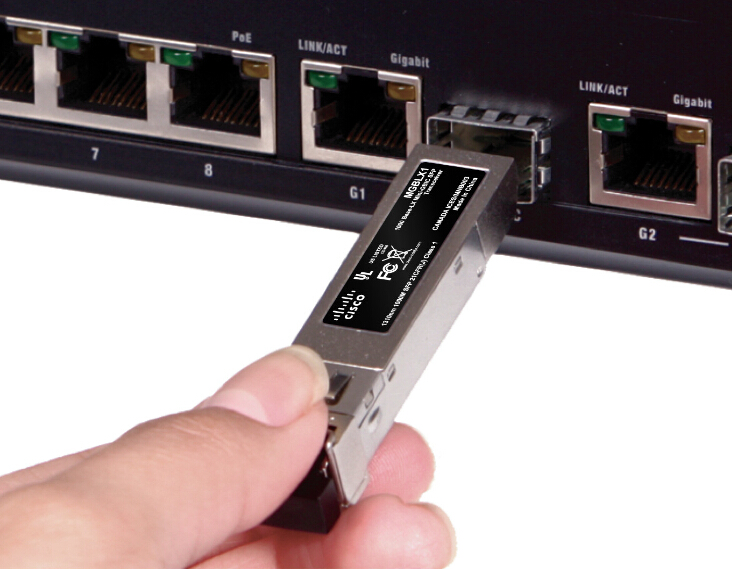
Step 2 Remove the mini-GBIC SFP module's rubber port cap.
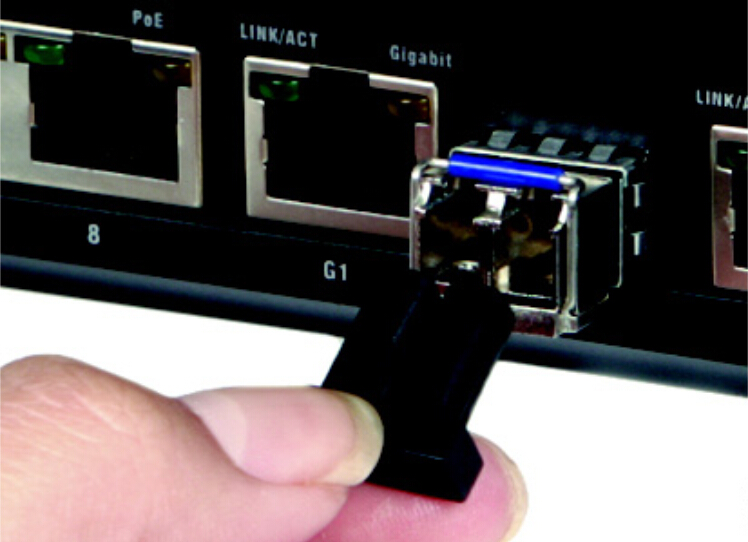
Step 3 Connect the fiber cable’s LC connector to the mini-GBIC SFP module’s port.
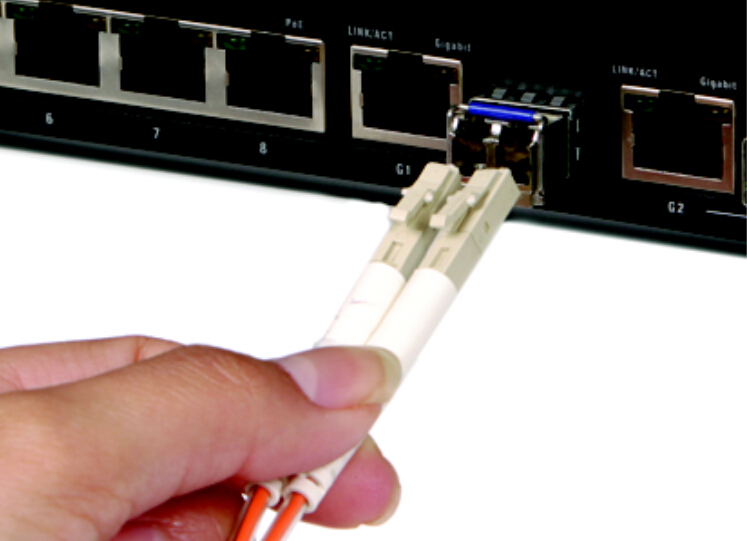
Step 4 Connect the other end of the cable to an SFP module to verify that the fiber connection is complete. For the Cisco MGBBX1, use the Cisco GLC-BX-D as the downstream SFP. For the Cisco MFEBX1, use the Cisco GLC-FE-100BX-D as the downstream SFP. The Cisco MGBBX1 and the Cisco MFEBBX1 support upstream only.
Removing the Transceiver
Step 1 Press the fiber cable’s connector and pull to remove the fiber cable from the mini-GBIC SFP module.
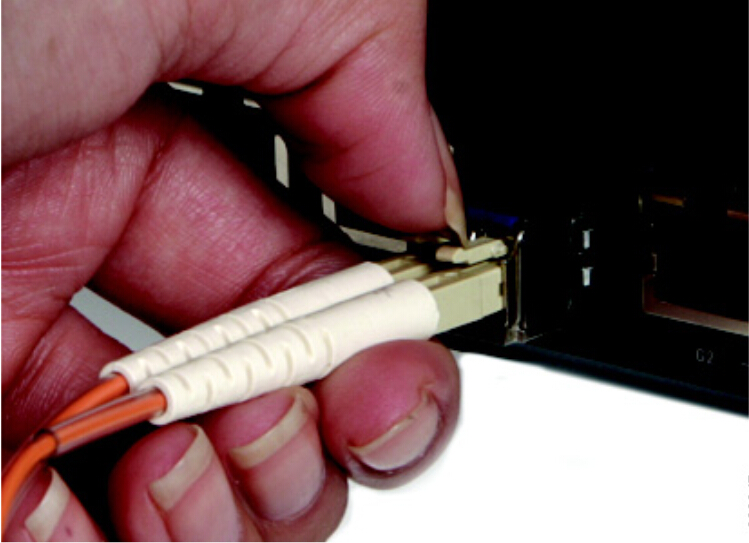
Step 2 Pull the module’s bail latch down.
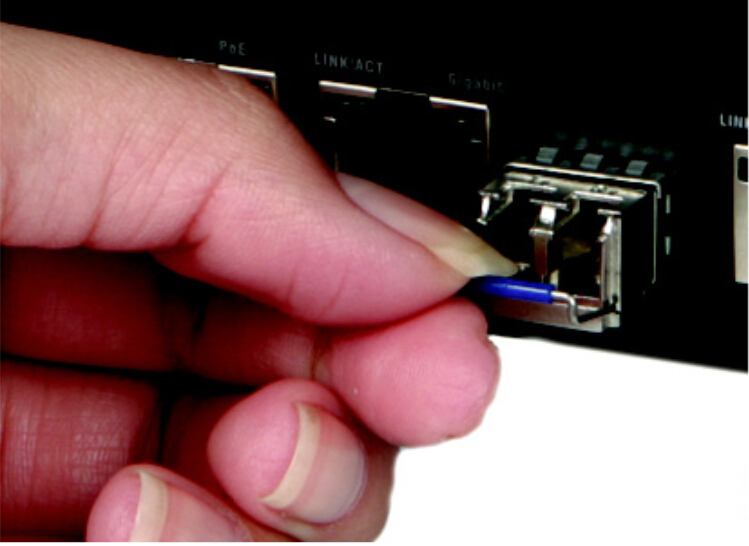
Step 3 Remove the mini-GBIC SFP module.
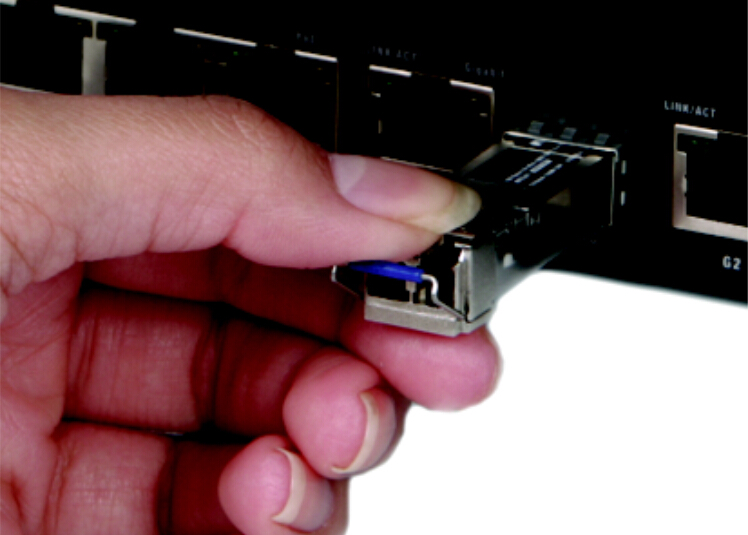
Removing the MGBT1
Step 1 Press the RJ-45 connector’s tab and pull to remove the cable from the gigabit SFP module.
Step 2 To remove the gigabit SFP module, begin by pulling the module’s pull tab.
Step 3 Remove the Gigabit SFP Module.
Tips: The Linksys company was founded in 1988. It is currently owned by Belkin, who bought it from Cisco, its owners from March 2003 to March 2013. Its products were branded as Linksys by Cisco when it was part of Cisco.
Article Source: Cisco Mini-GBIC SFP Transceiver Quick Start Guide
| < | veljača, 2015 | > | ||||
| P | U | S | Č | P | S | N |
| 1 | ||||||
| 2 | 3 | 4 | 5 | 6 | 7 | 8 |
| 9 | 10 | 11 | 12 | 13 | 14 | 15 |
| 16 | 17 | 18 | 19 | 20 | 21 | 22 |
| 23 | 24 | 25 | 26 | 27 | 28 | |
Srpanj 2015 (1)
Lipanj 2015 (4)
Svibanj 2015 (3)
Travanj 2015 (13)
Ožujak 2015 (10)
Veljača 2015 (8)
Siječanj 2015 (9)
Prosinac 2014 (4)
Dnevnik.hr
Gol.hr
Zadovoljna.hr
Novaplus.hr
NovaTV.hr
DomaTV.hr
Mojamini.tv
About Me
Ima Blogger, Just Share Various Fiber Optic Telecom Network Topics, Information, News, Questions, Sources and Network Solutions.

